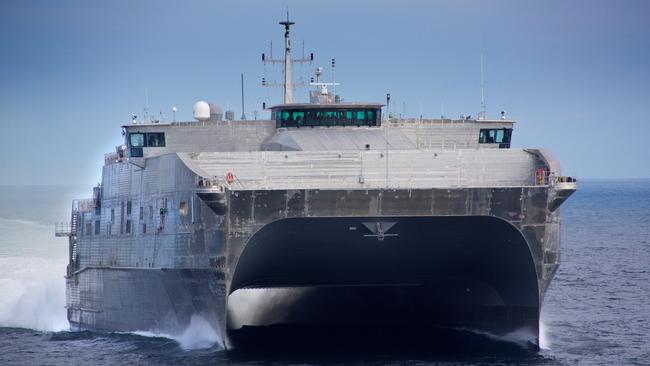
Austal is a lumpy performer at best. A company that perches on the precipice of greatness, with billions of dollars of shipbuilding contracts with the Australian and US governments, and yet fails to deliver consistent returns to shareholders.
News of Hanwha’s takeover approach follows rumours of two by US firms and a move by Australia’s richest man, Andrew Forrest, to become a significant shareholder.
The lure is potential riches from government contracts. Austal has an $11bn order book in the US alone, but cost blowouts have marred its performance.
Now the board is arguing it can’t seriously consider any takeover approach that doesn’t have the green light from both the Australian and US governments. If it stands firm on this, perhaps Forrest will be the only one that can take this company off the bourse.
“The board, together with its advisers, has considered … whether the transaction described in the indicative proposal would obtain the relevant regulatory approvals in Australia and the USA to enable it to proceed,” Austal said in a statement. “At present Austal is not satisfied that these mandatory approvals would be secured.”
Given Austal’s dismissive tone, it could be easy to overlook the fact that Hanwha is South Korea’s seventh-biggest conglomerate, with $US179.7bn ($276bn) of assets and annual revenue of $US65.3bn.
Not only that, it has a massive enterprise in Australia building tanks for the Australian Defence Force, and strong ties into the US, where it uses the American integrated naval weapons system Aegis on Hanwha-built Korean warships.
Austal’s soundings that Hanwha would have issues with both countries seems a stretch – although, to be fair, the approvals process could be slow.
“There is no foundation of the claim that the Foreign Investment Review Board would reject Hanwha’s acquisition of the company,” Hanwha executive vice-president David Kim said in an unusually forcefully worded statement.
“Hanwha has already obtained FIRB approval for prior investments in Australia and has a proven track record of investment in Australia’s defence industrial base, being the contracted supplier of infantry fighting vehicles, self-propelled howitzers and ammunition resupply vehicles with significant investment in a Geelong manufacturing facility that employs local workers.”
After rejecting the Hanwha approach, Austal was at pains to background on “Australia’s special relationship with the US”, but the reality is that this nation is not its only close friend. South Korea, which plays the key role in protecting the world from the whims of Kim Jong-un, would have special status with the US, too.
The US Department of Defence put out a statement in November last year that affirmed the close relationship between Korea and the US.
“In 1953 the United States and Republic of Korea signed the Mutual Defence Treaty pledging to promote peace, defend against external threats, and strengthen collective defence in the Pacific region,” US Secretary of Defence Lloyd Austin said. “Seventy years later, the US-Republic of Korea Alliance now stands as one of the world’s premier alliances.”
This statement was in relation to the role South Korea plays in protecting the region from its neighbour in the north, but the US and South Korea have several bilateral agreements, the US Eighth Army section is permanently based in Korea, and there are several Korean companies that produce US military technology under licence agreements.
The truth is that Austal is probably just engaging in takeover tactics. But if the board is looking after the best interests of all shareholders rather than just trying to fend off approaches, it may want to tell Hanwha to drop some of its conditions, or agree to a significant break fee rather than try to tell the market the Korean company would struggle to get government sign-off.
Then of course there is the price, and a 28 per cent premium probably isn’t going to cut it.
As Wilson Asset Management’s Oscar Oberg points out, despite Austal’s current under performance – including a drop in first-half revenue and profit – it does have strong contracts in place.
“The business has gone through periods where it’s been fantastic and it has long-dated contracts, and it’s a very strategic business when you think about their position in the United States and Australia with the government and defence,” Oberg said.
The fund manager, who no longer owns Austal shares, believes that because the company’s contracts are so “lumpy” it would be best off in private hands.
“If you ask yourself, should this business be listed, the answer is probably no,” Oberg said.
The elephant in the room here is, of course, how does the nation feel about having another important company sold off to any foreign investor, and does Austal actually fit that bill?
Is it in Australia’s national interest to lose its biggest ship builder to foreign hands?
This point could be argued both ways and is best played out in backrooms of the Canberra bubble, but for all the arguments about losing another “great” Australian asset, it’s worth considering how great this asset actually is.
Shareholders that bought in at the IPO have only just over doubled their money since 1998, including Tuesday’s 10 per cent-plus share price rise following the announcement about the takeover approach. The shares are worth half of what they traded for in 2019, when the company had a few years of rising profits.
Looking at Hanwha (purely because it is the current company with an offer on the table), it has the world’s second-largest shipyard, at Okpo. The company has been building ships for more than 50 years and has experience across warships and submarines for its own country as well as for the UK and Norway.
“Hanwha is a credible buyer with a highly competitive offer,” said the company’s Kim.
Compare that with Austal, which had a liquidity crisis in 2012 that resulted in the firm having its shares halted from trading on the stock exchange for more than 10 days while it considered capital management solutions, a fraud scandal, and years of lumpy shareholder returns.
Hanwha is offering $2.825 a share via a scheme of arrangement that would require an Austal board recommendation and shareholder approval, as well as approval by FIRB, the Committee on Foreign Investment in the US (CFIUS) and the US Defence Counterintelligence and Security Agency.
If Austal wants to stay as a publicly listed company in Australia, it might be best off focusing on delivering profits from the strategic shipbuilding agreement it entered into with the Australian government last year, and the new US navy contract worth $1.3bn.
Arguing that a Korean conglomerate with close links to the Australian and US military would not receive government approvals may not stand up as a defence for very long.




Directors of Austal, Australia’s only listed naval ship builder, must have had very solid legal advice before dismissing a $1bn non-binding takeover approach by the Republic of Korea’s Hanwha with a seemingly in-built poison pill that makes a foreign takeover all but impossible.